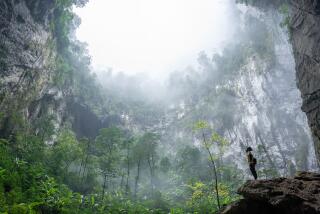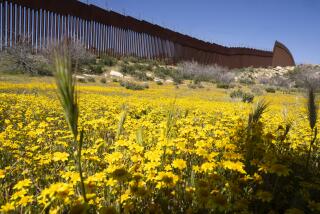Ho Chi Minh Trail’s wildlife army
- Share via
KEO SEIMA, CAMBODIA — Four decades after U.S. warplanes plastered it with bombs, a remote corner of the old Ho Chi Minh Trail in Cambodia is making a comeback as a treasure trove of endangered wildlife.
Tigers prowl imperiously down tracks where weapons-laden North Vietnamese trucks once rolled. Elephants shepherd their young past giant bomb craters to drink at jungle water holes, and rare apes call from treetops that used to hide communist forces from U.S. pilots.
Much of the credit for this swords-into-plowshares story goes to the New York-based Wildlife Conservation Society, which has managed and protected this forest in southern Mondulkiri province since 2002, in partnership with the Cambodian government. A former free-fire zone is now a strictly policed no-hunting preserve.
“It’s quite moving, I guess,” says Ed Pollard, the society’s technical advisor, standing in the dappled light beneath a canopy deep inside the jungle.
“Only 30 years ago, this was a hotbed. There were arms coming along this trail around this area. And now it’s all overgrown, and it seems like this untouched wilderness. In what used to be a cauldron of war, we’ve now got tigers and elephants and bears trotting backward and forward almost unmolested.”
And much more. According to the conservation group, at least 42 threatened species now thrive within the 1,160 square miles of what is officially the Seima Biodiversity Conservation Area.
A sharp eye can spot a charismatic primate called the black-shanked douc, gorging on treetop leaves in the late afternoon. Once it was thought that the species’ main home was Vietnam, but it’s now believed that half the world’s population lives in the once-devastated Cambodian forest. Large herds of gaur, magnificent horned wild cattle, roam the area, as do muntjac deer, banteng ox and wild pig, all vital prey for tigers.
Bird life -- ibis, vulture, eagle and hornbill -- abounds. So many Germain’s peacock-pheasants have been spotted that conservationists have scratched the species from the world endangered list.
Pollard, 33, of Britain concedes that some of the apparent growth in animal populations may be due to better counting. But he believes the evidence is strong that “all these species have grown in number.”
Some of the hardest data come from scores of motion-sensitive cameras bolted to trees and triggered when an invisible beam is broken. The cameras caught several shots of tigers in 2002, including one that stared into the lens with its mouth open in an apparent roar.
There have been no more tiger shots since, he says, because he is focused on measuring the abundance of tiger prey and set his cameras where deer, pigs and wild cattle are known to feed.
But even without tigers, the cameras are producing equally striking results; a leopard snaps as it advances toward the alien contraption with a curious expression; a nighttime shot that lights up the eyes of a horned, black-coated gaur, giving it a demonic air; an old male elephant kneeling to scoop food from a dirt hole, a single yellowing tusk jutting out beside its muddied trunk.
It’s the kind of detailed, on-the-ground intelligence that would have served an army well in the Vietnam War.
Huge amounts of bombs were dropped on the Ho Chi Minh Trail in an ultimately futile effort to choke off Hanoi’s military supply line through ostensibly neutral Laos and Cambodia to battlefields in South Vietnam.
The trail was not a single roadway but a network estimated by U.S. officials to encompass some 1,500 miles of old roads, jungle paths and waterways.
Dao Pil, now 58, lived in the Cambodian sector at the time. He vividly recalls the North Vietnamese convoys and the frequent air strikes that drove him to hide in the forest.
“There were wild animals in the jungle,” he says, laughing. “But I wasn’t scared of them; I was scared of the bombs.”
Today, the sounds of war have given way to the mesmerizing pulse of soft tropical sound: the calls of yellow-cheeked crested gibbons fill the cool dawn air, and birds such as blue-eared barbets sing through the day.
But threats remain: the poachers of wildlife and timber, and illegal loggers. To counter them, armed Cambodian police run checkpoints and patrols right up to the Vietnam border. Arrests are common, and the police have an extensive collection of confiscated chain saws, snares, homemade crossbows and log-carrying vehicles.
The Wildlife Conservation Society hopes education will ensure the zone’s future. There are already clear signs that the ethnic Phnong people living within its boundaries support the conservation effort. Animists who believe the trees and animals are sacred, they abide by the no-hunting rule and act as an early-warning system, according to the Cambodian project’s deputy manager, Khiev Rithypoin.
“When they’re out in the forest and they see people who’ve crossed the border from Vietnam, they come and tell the police teams so we can send a patrol to catch them,” he says.
Close to a watering hole, in a clearing where he has just set up a camera, Pollard is fired with a vision of the future -- “that in 20 years people will come here and drive along the road and there’s a distinct chance there’ll be a tiger trotting along in front of you, and elephants will be grazing right in front of the camp. I really don’t think that’s an unachievable dream. I think that’s very much in our grasp.”
More to Read
Sign up for Essential California
The most important California stories and recommendations in your inbox every morning.
You may occasionally receive promotional content from the Los Angeles Times.










